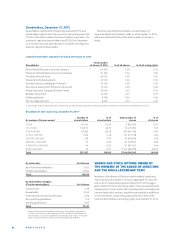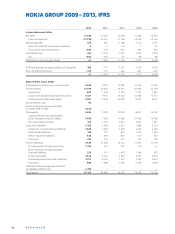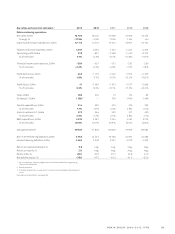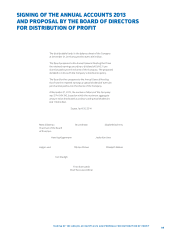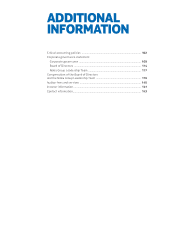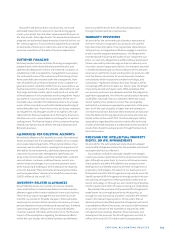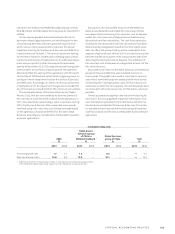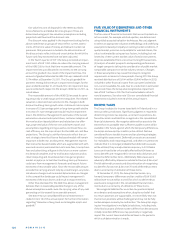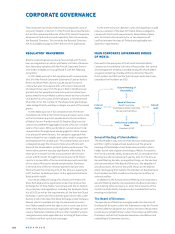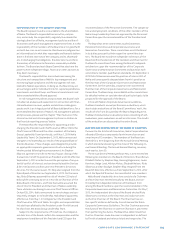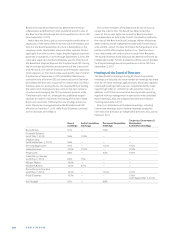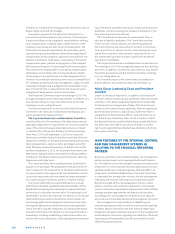Nokia 2013 Annual Report Download - page 106
Download and view the complete annual report
Please find page 106 of the 2013 Nokia annual report below. You can navigate through the pages in the report by either clicking on the pages listed below, or by using the keyword search tool below to find specific information within the annual report.NOKIA IN 2013
104
Our experience with claims of IPR infringement is that
there is typically a discussion period with the accusing party,
which can last from several months to years. In cases where
a settlement is not reached, the discovery and ensuing legal
process typically lasts a minimum of one year. For this rea-
son, IPR infringement claims can last for varying periods of
time, resulting in irregular movements in the IPR infringement
provision. In addition, the ultimate outcome or actual cost of
settling an individual infringement may materially vary from
our estimates.
LEGAL CONTINGENCIES
As discussed in Item A. “Litigation” and in Note and to
the consolidated fi nancial statements included in Item of
this annual report, legal proceedings covering a wide range
of matters are pending or threatened in various jurisdictions
against the Group. We record provisions for pending litigation
when we determine that an unfavorable outcome is probable
and the amount of loss can be reasonably estimated. Due
to the inherent uncertain nature of litigation, the ultimate
outcome or actual cost of settlement may materially vary from
estimates.
BUSINESS COMBINATIONS
We apply the acquisition method of accounting to account for
acquisitions of businesses. The consideration transferred in a
business combination is measured as the aggregate of the fair
values of the assets transferred, liabilities incurred towards
the former owners of the acquired business and equity instru-
ments issued. Acquisition-related costs are recognized as
expense in profi t and loss in the periods when the costs are
incurred and the related services are received. Identifi able as-
sets acquired and liabilities assumed are measured separately
at their fair value as of the acquisition date. Non-controlling
interests in the acquired business are measured separately
based on their proportionate share of the identifi able net
assets of the acquired business. The excess of the cost of the
acquisition over our interest in the fair value of the identifi able
net assets acquired is recorded as goodwill.
The determination and allocation of fair values to the
identifi able assets acquired and liabilities assumed is based
on various assumptions and valuation methodologies requir-
ing considerable management judgment. The most signifi cant
variables in these valuations are discount rates, terminal
values, the number of years on which to base the cash fl ow
projections, as well as the assumptions and estimates used to
determine the cash infl ows and outfl ows. Management deter-
mines the discount rates to be used based on the risk inherent
in the related activity’s current business model and industry
comparisons. Terminal values are based on the expected life
of products and forecasted life cycle and forecasted cash
fl ows over that period. Although we believe that the assump-
tions applied in the determination are reasonable based on
information available at the date of acquisition, actual results
may diff er from the forecasted amounts and the diff erence
could be material.
VALUATION OF LONG-LIVED ASSETS,
INTANGIBLE ASSETS AND GOODWILL
We assess the carrying amount of identifi able intangible
assets and long-lived assets if events or changes in circum-
stances indicate that such carrying amount may not be recov-
erable. We assess the carrying amount of our goodwill at least
annually, or more frequently based on these same indicators.
Factors that we consider important, and which could trigger an
impairment review, include the following:
■ signifi cant underperformance relative to historical or pro-
jected future results;
■ signifi cant changes in the manner of our use of these assets
or the strategy for our overall business; and
■ signifi cantly negative industry or economic trends.
When we determine that the carrying amount of intangible
assets, long-lived assets or goodwill may not be recoverable
based upon the existence of one or more of the above indica-
tors of impairment, we measure recoverable value based on
discounted projected cash fl ows.
Recoverable value is based upon our projections of an-
ticipated discounted future cash fl ows. The most signifi cant
variables in determining cash fl ows are discount rates, termi-
nal values, the number of years on which to base the cash fl ow
projections, as well as the assumptions and estimates used
to determine the cash infl ows and outfl ows. Management de-
termines discount rates to be used based on the risk inherent
in the related activity’s current business model and industry
comparisons. Terminal values are based on the expected life
of products and forecasted life cycle and forecasted cash
fl ows over that period. While we believe that our assumptions
are appropriate, such amounts estimated could diff er materi-
ally from what will actually occur in the future. In assessing
goodwill, these discounted cash fl ows are prepared at the cash
generating unit level. Amounts estimated could diff er materi-
ally from what will actually occur in the future.
Goodwill is allocated to the Group’s cash-generating units
(“CGUs”) or groups of cash-generating units (CGUs) and re-
coverable value are prepared at the CGU level for the purpose
of impairment testing. The allocation of goodwill to our CGUs
is made in a manner that is consistent with the level at which
management monitors operations and are expected to benefi t
from the synergies arising from each of our acquisitions. As a
result of the sale of the D&S business, we have combined the
Smart Devices and Mobile Phones CGUs into a single Devices &
Services CGU and aligned with the scope of the business being
sold. The goodwill previously allocated to the two separate
CGUs has been allocated to the combined CGU for impair-
ment testing purposes. No goodwill was allocated to the new
Advanced Technology CGU.
In previous years we have defi ned the NSN’s operating seg-
ment as a single CGU. As a consequence of the acquisition of
the Siemens’ minority stake in NSN and the resulting change
in reportable segments, the Group has identifi ed two NSN
related groups of CGUs to which goodwill has been allocated:
Radio Access Networks within the Mobile Broadband operating
segment and Global Services.
Goodwill amounting to EUR million has been allocated
as follows: Devices & Services CGU (EUR million), HERE


